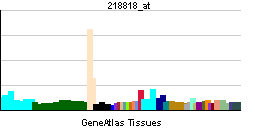FHL3
| Four and a half LIM domains 3 | |||||||||||||
|---|---|---|---|---|---|---|---|---|---|---|---|---|---|
 PDB rendering based on 1wyh. | |||||||||||||
| |||||||||||||
| Identifiers | |||||||||||||
| Symbols | FHL3 ; MGC19547; MGC23614; MGC8696; SLIM2 | ||||||||||||
| External IDs | Template:OMIM5 Template:MGI HomoloGene: 37928 | ||||||||||||
| |||||||||||||
| RNA expression pattern | |||||||||||||
 | |||||||||||||
| More reference expression data | |||||||||||||
| Orthologs | |||||||||||||
| Template:GNF Ortholog box | |||||||||||||
| Species | Human | Mouse | |||||||||||
| Entrez | n/a | n/a | |||||||||||
| Ensembl | n/a | n/a | |||||||||||
| UniProt | n/a | n/a | |||||||||||
| RefSeq (mRNA) | n/a | n/a | |||||||||||
| RefSeq (protein) | n/a | n/a | |||||||||||
| Location (UCSC) | n/a | n/a | |||||||||||
| PubMed search | n/a | n/a | |||||||||||
Four and a half LIM domains 3, also known as FHL3, is a human gene.[1]
LIM proteins are defined by the possession of a highly conserved double zinc finger motif called the LIM domain.[supplied by OMIM][1]
References
Further reading
- Morgan MJ, Madgwick AJ (1996). "Slim defines a novel family of LIM-proteins expressed in skeletal muscle". Biochem. Biophys. Res. Commun. 225 (2): 632–8. doi:10.1006/bbrc.1996.1222. PMID 8753811.
- Morgan MJ, Madgwick AJ (1999). "The LIM proteins FHL1 and FHL3 are expressed differently in skeletal muscle". Biochem. Biophys. Res. Commun. 255 (2): 245–50. doi:10.1006/bbrc.1999.0179. PMID 10049693.
- Lee SM, Tsui SK, Chan KK; et al. (1999). "Chromosomal mapping of a skeletal muscle specific LIM-only protein FHL3 to the distal end of the short arm of human chromosome 1". Somat. Cell Mol. Genet. 24 (3): 197–202. PMID 10226657.
- Li HY, Ng EK, Lee SM; et al. (2001). "Protein-protein interaction of FHL3 with FHL2 and visualization of their interaction by green fluorescent proteins (GFP) two-fusion fluorescence resonance energy transfer (FRET)". J. Cell. Biochem. 80 (3): 293–303. PMID 11135358.
- Strausberg RL, Feingold EA, Grouse LH; et al. (2003). "Generation and initial analysis of more than 15,000 full-length human and mouse cDNA sequences". Proc. Natl. Acad. Sci. U.S.A. 99 (26): 16899–903. doi:10.1073/pnas.242603899. PMID 12477932.
- Turner J, Nicholas H, Bishop D; et al. (2003). "The LIM protein FHL3 binds basic Krüppel-like factor/Krüppel-like factor 3 and its co-repressor C-terminal-binding protein 2". J. Biol. Chem. 278 (15): 12786–95. doi:10.1074/jbc.M300587200. PMID 12556451.
- Mils V, Lee SM, Joly W; et al. (2003). "LIM-only protein FHL3 interacts with CDC25B2 phosphatase". Exp. Cell Res. 285 (1): 99–106. PMID 12681290.
- Coghill ID, Brown S, Cottle DL; et al. (2003). "FHL3 is an actin-binding protein that regulates alpha-actinin-mediated actin bundling: FHL3 localizes to actin stress fibers and enhances cell spreading and stress fiber disassembly". J. Biol. Chem. 278 (26): 24139–52. doi:10.1074/jbc.M213259200. PMID 12704194.
- Purcell NH, Darwis D, Bueno OF; et al. (2004). "Extracellular signal-regulated kinase 2 interacts with and is negatively regulated by the LIM-only protein FHL2 in cardiomyocytes". Mol. Cell. Biol. 24 (3): 1081–95. PMID 14729955.
- Samson T, Smyth N, Janetzky S; et al. (2004). "The LIM-only proteins FHL2 and FHL3 interact with alpha- and beta-subunits of the muscle alpha7beta1 integrin receptor". J. Biol. Chem. 279 (27): 28641–52. doi:10.1074/jbc.M312894200. PMID 15117962.
- Takahashi K, Matsumoto C, Ra C (2005). "FHL3 negatively regulates human high-affinity IgE receptor beta-chain gene expression by acting as a transcriptional co-repressor of MZF-1". Biochem. J. 386 (Pt 1): 191–200. doi:10.1042/BJ20040775. PMID 15453830.
- Philippar U, Schratt G, Dieterich C; et al. (2005). "The SRF target gene Fhl2 antagonizes RhoA/MAL-dependent activation of SRF". Mol. Cell. 16 (6): 867–80. doi:10.1016/j.molcel.2004.11.039. PMID 15610731.
- Rual JF, Venkatesan K, Hao T; et al. (2005). "Towards a proteome-scale map of the human protein-protein interaction network". Nature. 437 (7062): 1173–8. doi:10.1038/nature04209. PMID 16189514.
- Cottle DL, McGrath MJ, Cowling BS; et al. (2007). "FHL3 binds MyoD and negatively regulates myotube formation". J. Cell. Sci. 120 (Pt 8): 1423–35. doi:10.1242/jcs.004739. PMID 17389685.
External links
- FHL3+protein,+human at the US National Library of Medicine Medical Subject Headings (MeSH)
| This protein-related article is a stub. You can help Wikipedia by expanding it. |
This article incorporates text from the United States National Library of Medicine, which is in the public domain.